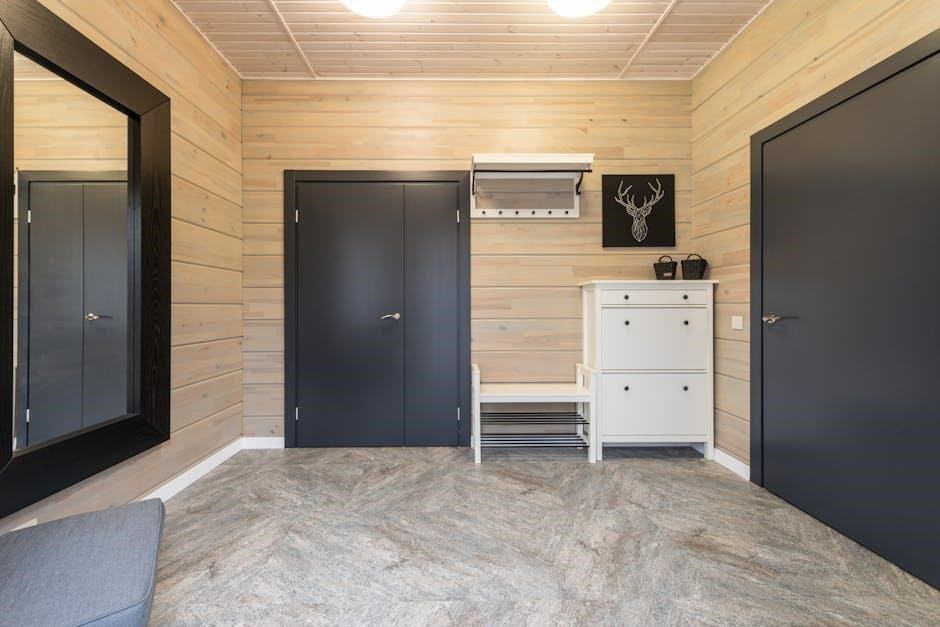Door Guides for Sliding Closet Doors: An Overview
Sliding closet door guides are essential components that ensure smooth and stable operation. They keep doors on track, preventing wobbling and derailment. Available in various materials and designs, they cater to different door thicknesses and floor types, enhancing functionality and aesthetics.
What are Sliding Closet Door Guides?
Sliding closet door guides are crucial hardware components designed to maintain the alignment and smooth operation of sliding closet doors. These guides, typically installed at the bottom or top of the door, ensure that the doors glide along their tracks without wobbling or coming off track. They provide stability and prevent the doors from rubbing against the frame, reducing friction and noise.
Available in various materials like plastic, metal, and nylon, these guides accommodate different door thicknesses and configurations. Selecting the right type of guide is essential for optimal performance and longevity of the sliding closet door system.

Types of Sliding Closet Door Guides
Sliding closet door guides come in various types, each designed for specific door configurations and applications. Common types include floor guides, top guides and adjustable guides, each serving a unique purpose in ensuring smooth door operation.
Floor Guides
Floor guides are mounted to the floor and provide support and stability to the bottom of sliding closet doors, ensuring they stay on track. These guides prevent doors from wobbling or swinging, enhancing safety and ease of use. They come in various designs, including those that accommodate different door thicknesses.
Some floor guides are designed for easy installation, used by numerous closet door manufacturers and are often made of plastic or metal for durability. Adjustable options are available to accommodate different floor surfaces and door alignments, making them versatile. Proper installation ensures smooth and reliable door operation.
Top Guides
Top guides, positioned at the upper track of sliding closet doors, play a crucial role in maintaining alignment and stability. These guides prevent the doors from tilting or falling off the track, ensuring smooth and secure operation. They often work in conjunction with rollers to facilitate effortless gliding.
Available in various materials like plastic, metal, or nylon, top guides are designed to withstand regular use. Proper installation of top guides is essential for preventing common issues such as doors coming off track or wobbling. They contribute to the overall functionality and longevity of sliding closet doors.
Adjustable Guides
Adjustable guides offer versatility in aligning sliding closet doors, accommodating slight variations in door thickness or track placement. These guides can be fine-tuned to ensure a snug fit, preventing wobbling and maintaining smooth operation. They are particularly useful when dealing with uneven floors or walls.
Commonly made from nylon or metal, adjustable guides provide durability and resistance to wear. Their adaptability makes them suitable for a range of door configurations and applications. Proper adjustment is essential to maximize their effectiveness and ensure the longevity of the sliding closet door system.
Materials Used in Door Guides
Door guides are manufactured using various materials, including plastic, metal, and nylon. Each material offers distinct advantages in terms of durability, cost, and performance, influencing the overall quality and longevity of the sliding closet door system.
Plastic Guides
Plastic guides are a common and cost-effective option for sliding closet doors. Often made from durable polymers, they offer a balance of affordability and functionality. Plastic guides are lightweight, easy to install, and resistant to corrosion. They are suitable for standard closet door applications. However, they may not be as robust as metal alternatives.
Plastic guides may wear down more quickly under heavy use. Some plastic guides are adjustable, offering flexibility in aligning the door. They are typically white or neutral in color, blending seamlessly with various door styles.
Metal Guides
Metal guides offer enhanced durability and strength for sliding closet doors. Constructed from materials like steel or aluminum, they withstand heavy use and provide long-lasting support. Metal guides are ideal for high-traffic areas or heavier doors. They resist wear and tear, ensuring smooth operation over time.
Metal guides may be more expensive than plastic options, but their robustness justifies the investment. They often come with a metallic finish, adding a sleek and modern touch to the closet. Proper installation is essential to maximize their performance and longevity.
Nylon Guides
Nylon guides are a popular choice for sliding closet doors due to their smooth, quiet operation. Nylon’s low-friction properties minimize noise and reduce wear on the door and track. These guides are durable and resistant to corrosion, making them suitable for various environments.
Nylon guides often come in adjustable designs, accommodating different door thicknesses. Their flexibility allows for easy installation and alignment. While not as strong as metal, nylon provides sufficient support for most residential closet doors. Regular cleaning ensures optimal performance and longevity.

Installation of Sliding Closet Door Guides
Installing sliding closet door guides involves a few basic steps. Proper alignment is crucial for smooth operation. With the right tools and a bit of patience, you can ensure your doors glide effortlessly.
Tools Required
To successfully install sliding closet door guides, you’ll need a few essential tools. A measuring tape ensures accurate placement, while a pencil helps mark drilling locations. A drill with appropriate bits is necessary for creating pilot holes. A screwdriver, either manual or powered, secures the guides in place.
A level guarantees that the guides are installed straight, preventing uneven door movement. Safety glasses protect your eyes from debris during drilling. Consider having a stud finder to locate wall studs for secure mounting. These tools will streamline the installation process, ensuring a professional and functional result for your sliding closet doors.
Step-by-Step Installation Process
Begin by measuring and marking the desired location for the door guides, ensuring alignment with the door’s track. Next, pre-drill pilot holes at the marked locations to prevent splitting the wood or damaging the floor. Position the door guide over the pilot holes and secure it using screws.
For floor-mounted guides, ensure they don’t obstruct the door’s movement. Test the door’s sliding motion to verify smooth operation and make any necessary adjustments. If using adjustable guides, fine-tune their position for optimal performance. Finally, tighten all screws and double-check the alignment for a secure and functional installation.
Troubleshooting Common Issues
Sliding closet doors can experience issues like coming off track or wobbling. Addressing these problems promptly ensures smooth operation and prevents further damage. Regular inspection and timely repairs can extend the lifespan of your sliding closet doors.
Doors Coming Off Track
One of the most common issues with sliding closet doors is them coming off track. This can be caused by several factors, including worn-out or damaged door guides, loose screws, or debris accumulation in the track. Inspect the guides for any signs of wear and tear, such as cracks or breaks. Ensure that the screws securing the guides are tightened properly. Clean the track regularly to remove any dirt or debris that may be obstructing the door’s movement. Replacing worn-out guides or adjusting their position can also help prevent doors from derailing. Proper alignment is essential for smooth operation.
Wobbly Doors
Wobbly sliding closet doors can be a nuisance, indicating underlying issues with the door guides or track system. This instability often stems from loose or damaged guides failing to provide adequate support. Inspect the guides for wear, ensuring they fit snugly against the door. Tighten any loose screws and consider replacing worn guides to restore stability. Additionally, check the track for debris or misalignment, as these can contribute to wobbling. Proper lubrication of the track can also minimize friction and enhance smooth, stable movement. Addressing these factors will help eliminate wobbling and ensure your closet doors glide effortlessly.

Factors to Consider When Choosing Door Guides
Selecting the right door guides involves considering door thickness, floor type, and desired aesthetics. Compatibility with existing hardware and ease of installation are also crucial. Prioritizing durability and material quality ensures long-term performance and satisfaction.
Door Thickness
Door thickness is a crucial factor when selecting sliding closet door guides. Guides are designed to accommodate specific door thicknesses, typically ranging from 3/4 inch to 1-3/8 inches. Choosing a guide that matches your door’s thickness ensures proper alignment and prevents the door from rubbing against the track or becoming misaligned. Using an incompatible guide can lead to operational issues, premature wear, and potential damage to the door or track. Therefore, accurately measuring door thickness and selecting a compatible guide is essential for smooth and reliable sliding door function. Adjustable guides offer versatility for varying thicknesses.
Floor Type
The type of flooring significantly influences the selection of sliding closet door guides. For carpeted floors, guides with carpet risers are essential to ensure proper clearance and prevent the door from dragging. Hardwood or tile floors benefit from low-profile guides that minimize visual impact and prevent scratching. Floating floors require special consideration, as installing guides directly onto them may hinder expansion and contraction. In such cases, alternative mounting solutions or specialized guides designed for floating floors are necessary. Selecting the appropriate guide based on floor type ensures optimal performance, prevents damage, and maintains the floor’s integrity and functionality over time.

Maintenance Tips for Door Guides
Regular maintenance of sliding closet door guides ensures smooth operation and longevity. Key practices include cleaning to remove debris and lubrication to reduce friction. These simple steps prevent issues like doors coming off track or becoming wobbly.
Cleaning
Regular cleaning is crucial for maintaining the functionality of sliding closet door guides. Dust, debris, and accumulated dirt can hinder smooth operation, causing friction and potential damage. Use a vacuum cleaner with a brush attachment to remove loose particles from the guides and tracks. For stubborn grime, a damp cloth with mild soap can be used to gently wipe the surfaces. Ensure the guides are completely dry before resuming normal use. Avoid harsh chemicals or abrasive cleaners, as they can damage the material of the guides. Consistent cleaning prevents build-up and ensures effortless sliding for years to come.
Lubrication
Proper lubrication is essential for the smooth and quiet operation of sliding closet door guides. Over time, friction can increase, causing the doors to stick or make noise. Applying a lubricant reduces friction and ensures effortless gliding. Use a silicone-based lubricant or dry lubricant spray, as these won’t attract dust and debris like oil-based products. Apply the lubricant sparingly to the contact points between the door and the guide. Wipe away any excess lubricant to prevent it from attracting dirt. Regular lubrication, typically every few months, keeps the doors moving smoothly and extends the lifespan of the guides.

Be First to Comment